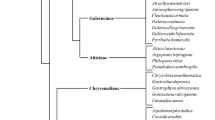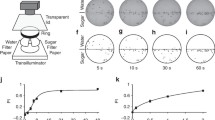Abstract
Chemical stimulation of contact chemoreceptors located on the legs of locusts evokes withdrawal movements of the leg. The likelihood of withdrawal depends on the site of stimulation, in addition to the identity and concentration of the chemical stimulus. A significantly higher percentage of locusts exhibit leg avoidance movements in response to stimulation of distal parts of the leg with any given chemical stimulus compared to proximal sites. Moreover, the percentage of locusts exhibiting avoidance movements is correlated with the density and sensitivity of chemoreceptors on different sites of an individual leg. The effectiveness of chemical stimulation also differs between the fore and hind legs, with NaCl evoking a higher probability of leg withdrawal movements on the foreleg. Moreover, sucrose was less effective than NaCl at evoking withdrawal movements of the foreleg, particularly at low concentrations. The gradients in behavioural responses can be partially attributed to differences in the responsiveness and density of the contact chemoreceptors. These results may reflect the different specialization of individual legs, with the forelegs particularly involved in food selection.







Similar content being viewed by others
References
Bernays EA, Chapman RF (1978) Plant chemistry and acridoid feeding behaviour. In: Harborne JB (ed) Biochemical aspects of plant and animal coevolution. Academic Press, London, pp 99–141
Blaney WM, Chapman RF (1970) The functions of the maxillary palps of Acrididae (Orthoptera). Entomol Exp Appl 13:363–376
Burrows M (1992) Reliability and effectiveness of transmission from exteroceptive sensory neurons and spiking local interneurons in the locust. J Neurosci 12:1477–1489
Burrows M (1996) The neurobiology of an insect brain. Oxford University Press, Oxford , 682 pp
Chapman RF (1977) The role of the leaf surface on food selection by acridids and other insects. Colloq Int Cent Natl Rech Sci 265:133–149
Chapman RF (1982) Chemoreception: the significance of sensillum numbers. Adv Insect Physiol 16:247–356
Christensen TA, Waldrop BR, Hildebrand JG (1998) Multitasking in the olfactory system: context-dependent responses to odors reveal dual GABA-regulated coding mechanisms in single olfactory projection neurons. J Neurosci 18:5999–6008
Dethier VG (1976) The hungry fly. Harvard University Press, Cambridge, 489 pp
Di Lorenzo PM (2000) The neural code for taste in the brain stem: response profiles. Physiol Behav 69:87–96
Di Lorenzo PM, Lemon CH, Reich CG (2003) Dynamic coding of taste stimuli in the brain stem: effects of brief pulses of taste stimuli on subsequent taste responses. J Neurosci 23:8893–8902
Hodgson ES, Lettvin JY, Roeder KD (1955) Physiology of a primary chemoreceptor unit. Science 122:417–418
Kajii Y, Shingai T, Kitagawa J, Takahashi Y, Taguchi Y, Noda T, Yamada Y (2002) Sour taste stimulation facilitates reflex swallowing from the pharynx and larynx in the rat. Physiol Behav 77:321–325
Katz DB, Nicolelis MAL, Simon SA (2002) Gustatory processing is dynamic and distributed. Curr Opin Neurobiol 12:448–454
Kendall MD (1970) The anatomy of the tarsi of Schistocerca gregaria Forskål. Z Zellforsch 109:112–137
Kitagawa J, Shingai T, Takahashi Y, Yamada Y (2002) Pharyngeal branch of the glossopharyngeal nerve plays a major role in reflex swallowing from the pharynx. Am J Physiol Regulatory Integr Comp Physiol 282:R1342–R1347
Ma WC, Schoonhoven LM (1973) Tarsal contact chemosensory hairs of the large white butterfly Pieris brassicae and their possible role in oviposition behaviour. Entomol Exp Appl 16:343–357
Newland PL (1998) Avoidance reflexes mediated by contact chemoreceptors on the legs of locusts. J Comp Physiol A 183:313–324
Newland PL (1999) Processing of gustatory information by spiking local interneurons in the locust. J Neurophysiol 82:3149–3159
Newland PL, Burrows M (1994) Processing of mechanosensory information from gustatory receptors on a hind leg of the locust. J Comp Physiol A 174:399–410
Newland PL, Rogers SM, Gaaboub I, Matheson T (2000) Parallel somatotopic maps of gustatory and mechanosensory neurons in the central nervous system of an insect. J Comp Neurol 425:82–96
Rogers SM, Newland PL (2000) Local movements evoked by chemical stimulation of the hind leg of the locust Schistocerca gregaria. J Exp Biol 203:423–433
Rogers SM, Newland PL (2002) Gustatory processing in thoracic local circuits of locusts. J Neurosci 22:8324–8333
Siegler MVS, Burrows M (1986) Receptive fields of motor neurons underlying local tactile reflexes in the locust. J Neurosci 6:507–513
Simpson SJ (1992) Mechanoresponsive neurones in the suboesophageal ganglion of the locust. Physiol Entomol 17:351–369
Simpson SJ, James S, Simmonds MSJ, Blaney WM (1991) Variation in chemosensitivity and the control of dietry selection behaviour in the locust. Appetite 17:141–154
Städler E, Renwick JAA, Radke CD, Sachdevgupta K (1995) Tarsal contact chemoreceptor response to glucosinolates and cardenolides mediating oviposition in Pieris rapae. Physiol Entomol 20:175–187
Watson AHD (1986) The distribution of GABA-like immunoreactivity in the thoracic nervous system of the locust Schistocerca gragaria. Cell Tissue Res 246:331–341
White PR, Chapman RF (1990) Tarsal chemoreception in the polyphagous grasshopper Schistocerca americana—behavioral assays, sensilla distributions and electrophysiology. Physiol Entomol 15:105–121
Acknowledgements
This work was supported by an award from the BBSRC to PLN. We are grateful to Ed Hunt, Paul Yates and Sarah Young for their comments on an earlier version of the manuscript and to Dr Steve Rogers for numerous discussions and advice on statistical analysis. The experiments comply with the “Principles of animal care”, publication No. 86-23 (revised 1985) of the National Institute of Health (USA) and with current UK laws.
Author information
Authors and Affiliations
Corresponding author
Rights and permissions
About this article
Cite this article
Gaaboub, I., Schuppe, H. & Newland, P.L. Position-dependent sensitivity and density of taste receptors on the locust leg underlies behavioural effectiveness of chemosensory stimulation. J Comp Physiol A 191, 281–289 (2005). https://doi.org/10.1007/s00359-004-0582-8
Received:
Revised:
Accepted:
Published:
Issue Date:
DOI: https://doi.org/10.1007/s00359-004-0582-8




